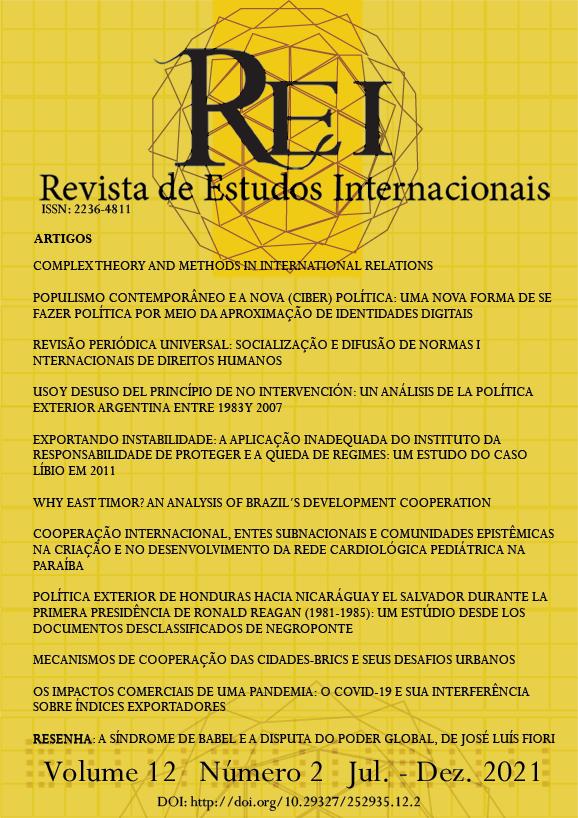EXPORTANDO INSTABILIDADE: A APLICAÇÃO INADEQUADA DO INSTITUTO DA RESPONSABILIDADE DE PROTEGER E A QUEDA DE REGIMES, UM ESTUDO DO CASO LÍBIO EM 2011
DOI:
https://doi.org/10.29327/252935.12.2-5Resumo
Este artigo aborda a intervenção autorizada pelo Conselho de Segurança das Nações Unidas à Líbia, em 2011, por meio das Resoluções 1970 e 1973. Diante da aparente similaridade entre este episódio e outros anteriores em que o paradigma da Responsabilidade de Proteger não havia sido invocado, o artigo tem como objetivo a investigação da aplicação do instituto neste cenário, a partir de um estudo de caso, dando atenção às particularidades do cenário político líbio, observando a evolução e a institucionalização da R2P e fazendo um breve comparativo com a intervenção ao Iraque. Finalmente, o estudo tem sua hipótese confirmada, diante da elevada similaridade com o caso iraquiano e aparente falta de preocupação da coalisão interventora em garantir a construção de uma paz duradoura na Líbia.
Referências
AL-GADDAFI, Muammar (1975). The Green Book. Publicado em: [http://openanthropology.org/libya/gaddafi-green-book.pdf] Disponibilidade: 18/09/2021.
ANDERSON, Lisa. (2011) Demystifying the Arab spring: parsing the differences between Tunisia, Egypt, and Libya. Foreign Affairs, 90 (2): 2-7.
BARRY, Ben. (2011) Libya's Lessons. Survival: Global Politics and Strategy, 53 (5): 5-14.
BELLAMY, Alex J. (2009) Responsibility to Protect. Cambridge: Polity Press.
______. (2010) The Responsibility to protect—five years On. Ethics & International Affairs, 24 (2): 143-190.
______. (2011) Global Politics and the Responsibility to Protect: From Words to Deeds. New York: Routledge.
BRASIL, Bruno Berrettini Camponês do (2017). Líbia: um estudo da intervenção internacional de 2011 e de seus aspectos jurídicos e políticos. Dissertação de Mestrado apresentada ao Instituto de Relações Internacionais da Universidade de São Paulo (Orientador: Prof. Dr. Pedro Bohomoletz de Abreu Dallari).
BROSIG, Malte. (2013) Um Sistema integrado de segurança global e regional para a R2P: já chegamos lá? In HAMANN, Eduarda; MUGGAH, Robert (org.). A implementação da responsabilidade de proteger: novos rumos para a paz e a segurança internacional? Brasília: Instituto Igarapé, 19-25.
CHANDLER, David. (2004) The Responsibility to Protect? Imposing the “Liberal Peace”. International Peacekeeping, 11 (1): 59-81.
COPPEDGE, Michael. (2019) V-Dem Country Coding Units v9. Varieties of Democracy (V-Dem) Project. Gothenburg: Department of Political Science, University of Gothenburg.
EVANS, Gareth. (2008) The Responsibility to Protect: Ending Mass Atrocity Crimes Once and For All. Washington D.C.: The Brookings Institution.
HALLIDAY, Fred. (2007) Crises of the Middle East: 1914, 1967, 2003. Publicado em Open Democracy. 15 June: [www.opendemocracy.net/crises_of_the_middle_east_1914_1967_2003]. Disponibilidade: 18/10/2019.
KABATI, Christian. (2015) NATO Military Operations in Libya in Relation to International Humanitarian Law. In SMITH-WINDSOR, Brooke A. (Ed.). AU-NATO Collaboration: Implications and Prospects. Roma: NATO Defense College, 135-145.
KALDOR, Mary. (2011) Libya: war or humanitarian intervention?. Publicado em Open Democracy [http://www. opendemocracy.net/mary-kaldor/libya-war-or-humanitarian-intervention]. Disponibilidade: 05/12/2019.
ICISS. (2001) The Responsibility to Protect: report of the International Commission on Intervention and State Sovereignty. Ottawa: International Development Research Centre.
MARSHALL, Monty; GURR, Ted; JAGGERS, Keith. (2019) Polity IV Project: Political Regime Characteristics and Transitions, 1800-2018. Vienna: Center for Systemic Peace.
MAZOWER, Mark. (2010) No enchanted palace: the end of empire and the ideological origins of the United Nations. Princeton: Princeton University Press.
MESQUITA, Bruce Bueno; DOWN, George. (2006) Intervention and Democracy, International Organization, 60 (3): 627-649.
NASSER, Reginaldo. (2011) Turbulências no Mundo Árabe: Rumo a uma nova ordem? Revista Tempo do Mundo, 3 (2):141-167.
OBAMA, Barack; CAMERON, David; SARKOZY, Nicolas. (2011) Libya’s Pathway to Peace. Publicado em The New York Times, 14 abril. [https://www.nytimes.com/2011/04/15/opinion/15iht-edlibya15.html]. Disponibilidade: 03/02/ 2021.
ORGANIZAÇÃO DAS NAÇÕES UNIDAS. (2011a) Documento. S/RES/1973 de 2011.
______. (2011b) Documento S/RES/1970.
______. (2011c) 66th session, 6528th meeting. UN Doc. S/PV. 6528.
PACK, Jason; BARFI, Barak. (2012) In War’s Wake: The Struggle for Post-Qadhafi Libya. Policy Focus, 118: 1-38.
PRASHAD, Vijay. (2012) Arab spring, Libyan winter. Oakland: AK Press.
SANTOS, Maria; TEIXEIRA, Ulysses. (2014) It is possible to export democracy by the uso of force? Military interventions in Iraq and Libya. FLACSO-ISA Joint International Conference: Global and Regional Powers in a Changing World. Buenos Aires, 1: 1-35.
SCHWARZ, Rolf. (2007) Rentier States and International Relations Theory. Conference on International Relations, 4 (6): 110-139.
THE NEW YORK TIMES. (2002) Cheney says peril of a nuclear Iraq justifies attack. Publicado em The New York Times, 26 August [https://archive.nytimes.com/www.nytimes.com/learning/teachers/featured_articles/20020828wednesday.html]. Disponibilidade: 09/11/2019.
______. (2011) U.S.-led assault nears goal in Libya. Publicado em The New York Times, 21 March [https://www.nytimes.com/2011/03/22/world/africa/22libya.html]. Disponibilidade:16/11/2019.
THE WHITE HOUSE. (2002) The National Security Strategy. National Security Council. September. Publicado em [http://georgewbush-whitehouse.archives.gov/nsc/nss/2002]. Disponibilidade: 10/11/2019.
______. (2011) Remarks by the President on Libya, 19 March. Publicado em [https://www.whitehouse.gov/the-press-office/2011/03/19/remarks-president-libya]. Disponibilidade:19/11/2019.
VANDEWALLE, Dirk. (2012) A History of Modern Libya. Nova York: Cambridge University Press.
WILSON, David. (2012) The Arab spring: comparing US reactions in Libya and Syria. Carlisle: United States Army War College.


